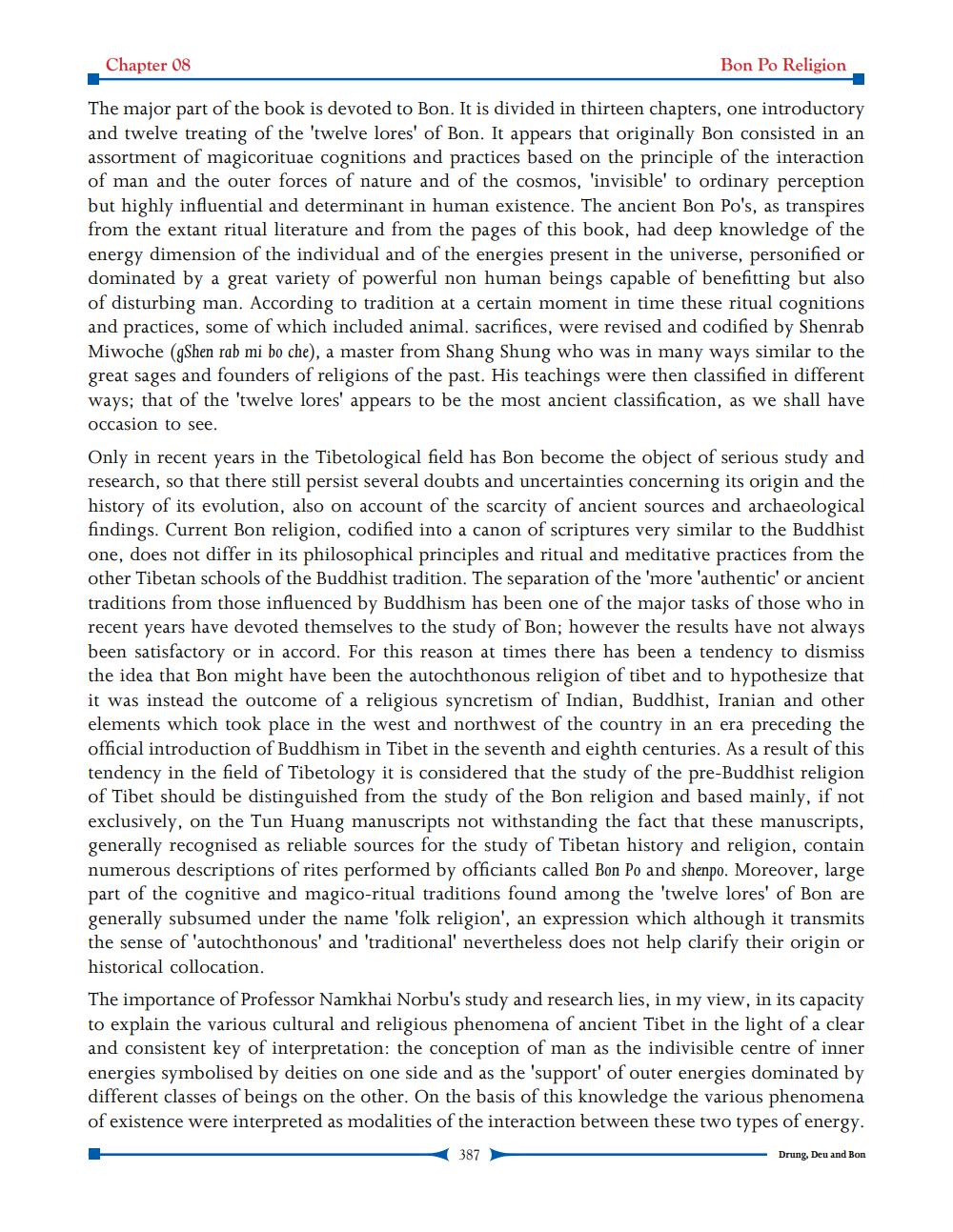________________
Chapter 08
Bon Po Religion
The major part of the book is devoted to Bon. It is divided in thirteen chapters, one introductory and twelve treating of the 'twelve lores' of Bon. It appears that originally Bon consisted in an assortment of magicorituae cognitions and practices based on the principle of the interaction of man and the outer forces of nature and of the cosmos, 'invisible' to ordinary perception but highly influential and determinant in human existence. The ancient Bon Po's, as transpires from the extant ritual literature and from the pages of this book, had deep knowledge of the energy dimension of the individual and of the energies present in the universe, personified or dominated by a great variety of powerful non human beings capable of benefitting but also of disturbing man. According to tradition at a certain moment in time these ritual cognitions and practices, some of which included animal. sacrifices, were revised and codified by Shenrab Miwoche (gShen rab mi bo che), a master from Shang Shung who was in many ways similar to the great sages and founders of religions of the past. His teachings were then classified in different ways; that of the 'twelve lores' appears to be the most ancient classification, as we shall have occasion to see.
Only in recent years in the Tibetological field has Bon become the object of serious study and research, so that there still persist several doubts and uncertainties concerning its origin and the history of its evolution, also on account of the scarcity of ancient sources and archaeological findings. Current Bon religion, codified into a canon of scriptures very similar to the Buddhist one, does not differ in its philosophical principles and ritual and meditative practices from the other Tibetan schools of the Buddhist tradition. The separation of the 'more 'authentic' or ancient traditions from those influenced by Buddhism has been one of the major tasks of those who in recent years have devoted themselves to the study of Bon; however the results have not always been satisfactory or in accord. For this reason at times there has been a tendency to dismiss the idea that Bon might have been the autochthonous religion of tibet and to hypothesize that it was instead the outcome of a religious syncretism of Indian, Buddhist, Iranian and other elements which took place in the west and northwest of the country in an era preceding the official introduction of Buddhism in Tibet in the seventh and eighth centuries. As a result of this tendency in the field of Tibetology it is considered that the study of the pre-Buddhist religion of Tibet should be distinguished from the study of the Bon religion and based mainly, if not exclusively, on the Tun Huang manuscripts not withstanding the fact that these manuscripts, generally recognised as reliable sources for the study of Tibetan history and religion, contain numerous descriptions of rites performed by officiants called Bon Po and shenpo. Moreover, large part of the cognitive and magico-ritual traditions found among the 'twelve lores' of Bon are generally subsumed under the name 'folk religion', an expression which although it transmits the sense of 'autochthonous' and 'traditional' nevertheless does not help clarify their origin or historical collocation.
The importance of Professor Namkhai Norbu's study and research lies, in my view, in its capacity to explain the various cultural and religious phenomena of ancient Tibet in the light of a clear and consistent key of interpretation: the conception of man as the indivisible centre of inner energies symbolised by deities on one side and as the 'support' of outer energies dominated by different classes of beings on the other. On the basis of this knowledge the various phenomena of existence were interpreted as modalities of the interaction between these two types of energy.
387
Drung, Deu and Bon




